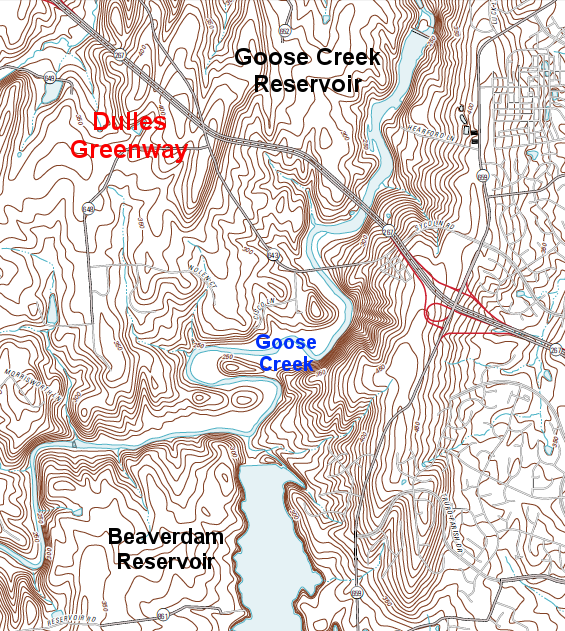
City of Fairfax dammed Goose Creek and Beaverdam Creek in Loudoun County to establish the city's water supply
Source: US Geological Survey (USGS), Leesburg 7.5 x7.5 topographic map (2011)
The Town of Fairfax was created in 1800, when Alexandria was transferred to the new District of Columbia. Residents initially dug individual wells to provide water for their personal use. In 1931, the town created a public water system using groundwater. A well drilled to 305 feet provided 60 gallons per minute to a single water tower located on Judicial Drive. A network of pipes distributed water by gravity to houses and 42 fire hydrants.1
By 2013, the city relied upon three water towers to supply nearly 12,000 customers and 500 fire hydrants. Tanks holding 4 million gallons each had been built near George Mason University at University Drive and Patriot Circle, and adjacent to Lyndhurst Drive. A smaller tank holding 0.9 million gallons was located near William Place.
In 1956, the Town of Fairfax (which became an independent city in 1961) decided to augment its 12 wells supplying the municipal system. It built a pipeline to connect with the City of Falls Church system, ensuring access to Potomac River water supplied by the US Army Corps of Engineers. Town officials also decided to dam Goose Creek and build a 22-mile pipeline along the Washington and Old Dominion Railroad to Hunter Mill Road, and then via Route 123/Route 50 into the city.2

City of Fairfax dammed Goose Creek and Beaverdam Creek in Loudoun County to establish the city's water supply
Source: US Geological Survey (USGS), Leesburg 7.5 x7.5 topographic map (2011)
Loudoun County supervisors and the "Keep the Goose Creek for Loudoun Committee" opposed the Goose Creek project as a water grab that would limit future development in the county. However, the water-short Town of Leesburg signed a contract to purchase water from the Town of Fairfax. After the Virginia Supreme Court ruled that Loudoun County zoning could not block construction, the county supervisors settled their lawsuits and the system went into operation in 1961.3
The Goose Creek Reservoir was designed to store 325 million gallons, but siltation soon reduced its capacity. At the same time, customer demand - and the need for the City of Fairfax to have a greater water supply - was projected to climb as the number of customers increased. After the mid-1960's drought, the city decided to expand its water supply by building a second reservoir.
There was not a second stream nearby with a steady flow that could fill a reservoir reliably, so a new dam was constructed on a tributary of Goose Creek. Water was stored behind the dam across Beaverdam Creek, then released when needed into the Goose Creek Reservoir.
Beaverdam Creek Reservoir was completed in 1972. It added 1.3 billion gallons of raw water storage to the 300 million gallons stored in the Goose Creek Reservoir. Since the watershed of Beaverdam Creek was only six square miles, it was not possible to fill and maintain a "full pool" in that large reservoir from natural runoff. Fairfax City used high flows in Goose Creek (with a drainage area of 347 square miles) to ensure there would be adequate water stored in the Beaverdam Creek Reservoir.
The city pumped excess water from Goose Creek to fill the reservoir during times when Goose Creek streamflow exceeded 215 cubic feet/second. The Beaverdam Creek Reservoir was planned to provide a one-time supplement to the city's water supply for at least 120 days, which would be sufficient in a drought equal to the record in 1930-31. The new reservoir was not expected to re-fill during a drought; that would occur only when the flow in Goose Creek exceeded 215 cubic feet/second again.4
After construction of the Goose Creek system, the City of Fairfax provided drinking water to customers in Loudon County and the Town of Leesburg, as well as to customers adjacent to the city boundaries. As described by the city later:5
In 1965, the City of Fairfax and the County of Fairfax signed a service area agreement defining exactly which area inside Fairfax County would be supplied from the city's water system. The city's authorized service area was never expanded after the 1965 deal. As development in the county progressed, the Fairfax County water authority built the infrastructure necessary to provide drinking water to new customers outside the city's defined service area.6
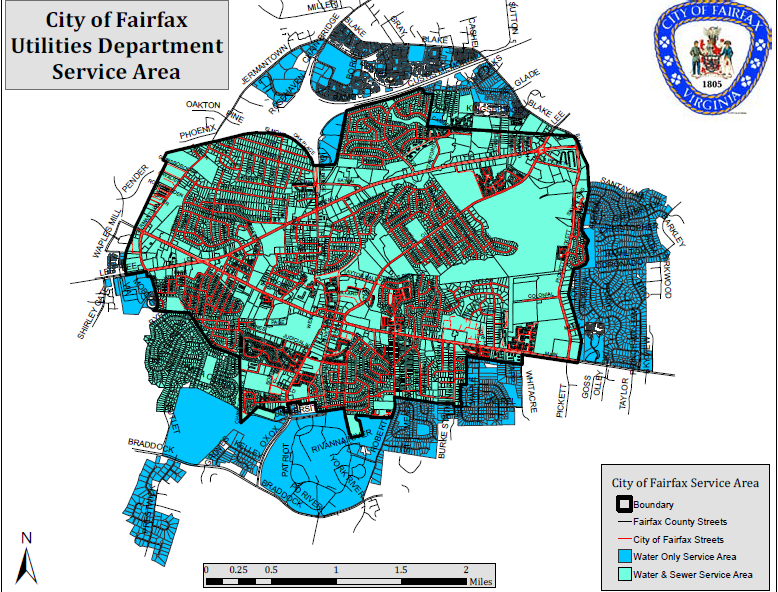
service area for City of Fairfax water and wastewater systems, showing how city water supplies some properties in Fairfax County (including Fairfax Campus of George Mason University)
Source: City of Fairfax Water and Wastewater Service Areas
The original capacity of the Goose Creek Reservoir was reduced by roughly 1/3 to just 200 million gallons by 1980. Additional siltation further reduced the volume of water stored in the reservoir, but a dredging project in 1997 removed enough silt to restore capacity to 200 million gallons. By 2011, however, capacity was estimated at just 120 million gallons. (Beaverdam Reservoir, with a much smaller watershed, has experienced less siltation.)7
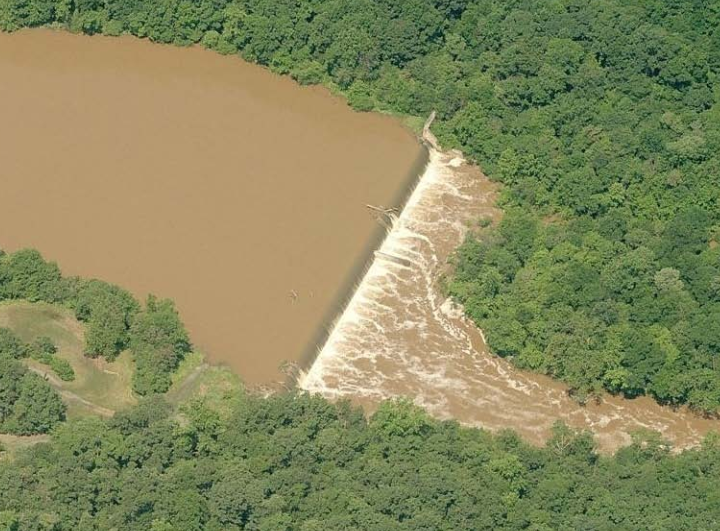
Goose Creek Dam, built in 1961 for interbasin transfer of drinking water to City of Fairfax
Source: City of Fairfax, Water Treatment Assessment and Financial Evaluation
After 50 years of service, the 1960-era system required extensive maintenance. In 2011, the city estimated the capital costs to maintain the current capacity, plus build a second pipeline to minimize the risk of interruption in water delivery. The total: nearly $50 million by 2016, including $15 million for the redundant pipeline.8
The city's water treatment plant, last upgraded in 1981, met Safe Drinking Water Act requirements - but it was obvious that the county water system (with two separate plants) was more reliable. In 2007, the City of Fairfax implemented voluntary water restrictions during a drought, while county customers were not requested to reduce their water use.9
At the same time, the city was losing customers and thus losing benefits from the economy of scale. Loudoun Water decided to build an independent system, while George Mason University negotiated lower rates and linked to the Fairfax Water system to have a competitive supplier.
In 2012, Fairfax city and county discussed merging their independent systems. One option was for the city to abandon (rather than upgrade) the city's old water treatment plant in Loudoun County, purchase treated water at wholesale rates from Fairfax Water, and maintain the city's distribution and billing system to provide water to customers. The main alternative was for the city to get out of the water business completely, and rely upon Fairfax Water to produce and distribute water directly to all of the city's water customers.
One factor affecting the city's planning was the impending loss of the utility's largest customer. Loudoun County was just one customer, but it purchased 3 million gallons/day, roughly the same amount used by customers within the City of Fairfax. Loudoun sales would end when that county built an independent water system by 2018.10
In 2012, the city chose to maintain its water independence, even though it would be more expensive than merging with the county. The Fairfax City Council decided to invest over $45 million to upgrade its water system, rather than to merge with the county water utility. The greater risk of equipment failure and the greater financial costs were less important than the benefits of maintaining control over the utility service.11
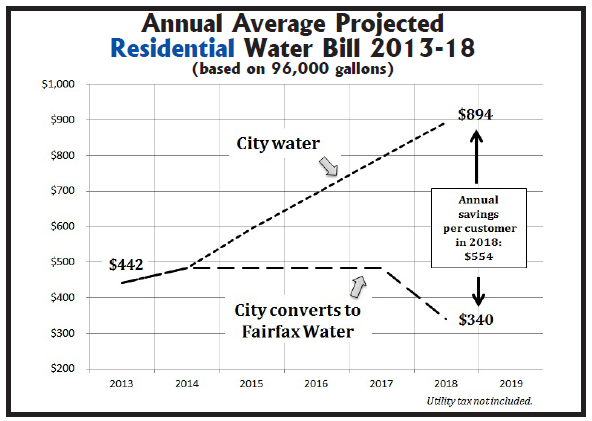
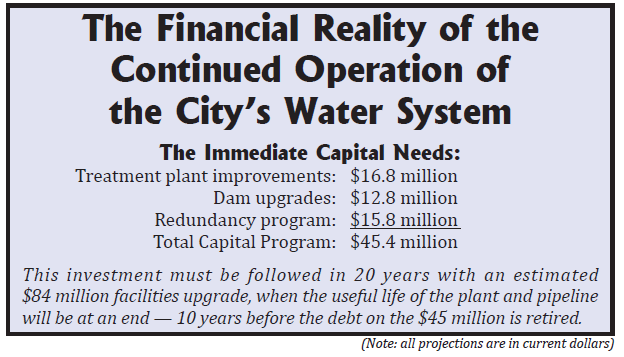
maintaining a separate water system would require substantially higher payments by City of Fairfax residential (and also commercial) water customers
Source: City of Fairfax, At a Crossroads: The Future of the City of Fairfax Water System
A year later in February 2013, the city switched direction. Fairfax City feared it might lose its lawsuit trying to block Fairfax County's claim that the county had legal authority to set rates for all water customers in the county, no matter who supplied the water. Even if the city won that lawsuit, the Fairfax County water system might compete through lower monthly rates and peel away the city's 3,250 customers located within the county. If the city lost almost 30% of its customers (including the Fairfax Campus of George Mason University), plus the Loudoun business, then a small number of ratepayers would face very high costs to maintain a separate water utility.12
As described by Washington Post columnist Tom Jackman, the deal involved the city paying $20 million to merge with the county water system, but that cost could be offset by selling the Loudoun County reservoir and land used for the treatment plant:13
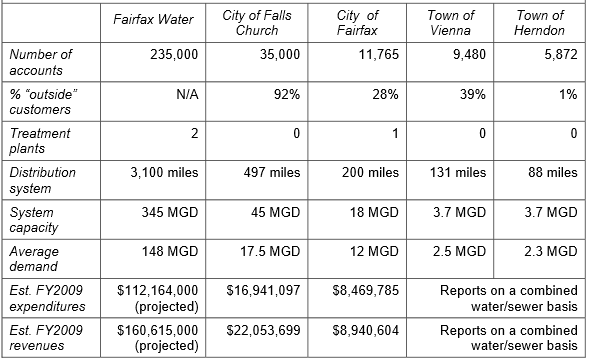
comparison of different water systems supplying customers in Fairfax County in 2010
Source: Fairfax County Consumer Protection Commission, Report on Rates Charged by Water Systems Serving Fairfax County Residents
Choosing to abandon its independent separate water system and consolidating with Fairfax Water eliminated the need for the City of Fairfax to obtain backup capacity, especially for drought:14
In the same newspaper article, a spokesperson for Fairfax Water noted:
In April, 2013, the City of Fairfax committed to the deal with Fairfax Water, adding 40,000 new customers to the 1.7 million already serviced by that utility. The city agreed to transfer all of its water infrastructure within the City of Fairfax and Fairfax county to Fairfax Water (in contrast to the Fairfax Water deal with the Town of Vienna, where the town retained ownership of its water mains). The City of Fairfax also retained ownership of its facilities on Goose Creek, expecting to sell them to offset the $20 million paid to join the Fairfax Water system.
Left unresolved in the deal at that time was the potential for a boundary adjustment between the city and county, comparable to the arrangements that helped resolve the water war between the County of Fairfax and the City of Falls Church. As described in a joint statement:15
The consolidation of the city and county water utilities in Fairfax did nothing to solve the water supply challenge faced by urbanizing Loudoun County. The county lost the opportunity to impound Goose Creek, within the county's boundaries, when the City of Fairfax won the legal battle to preempt that source in the 1950's.
In 2010, Loudoun County opted to meet its future drinking water supply requirements by pumping Potomac River water during periods of high flow, storing that water until needed in off-stream reservoirs. Rather than build a dam and flood another stream valley in the county to make a new reservoir, Loudoun Water negotiated with owners of local basalt quarries to acquire their holes in the ground when quarry operations cease. Loudoun Water will use the abandoned quarries as its off-stream reservoirs ("water banks") to store the Potomac River water.
In 2014, Loudoun also acquired the City of Fairfax water system, which became surplus when the city sold that utility to Fairfax Water. Loudoun Water purchased the Goose Creek Reservoir, Beaverdam Creek Reservoir, the city's old water treatment plant, and the portion of the Fairfax Water pipeline located within Loudoun County.
The county decided to replace rather than repair the treatment plant, with a capacity to generate 11 million gallons/day of drinking water. The 815 acres of land could be developed for residential and commercial use, helping Loudoun Water offset the $30 million purchase price. City of Fairfax residents were unaware of the sale until after it was completed, and one candidate for city council highlighted the lack of publicity in her successful campaign several months later.
Loudoun County had appraised the property at $55 million. The City of Fairfax chose to negotiate a direct sale, rather than get the parcel appraised and sell it on the open market. The city had received other offers, and they were substantially lower than the $30 million from Loudoun Water. A developer had proposed purchasing it for $21 million in 2011, and Fairfax Water offered $25 million in 2013.16
Three months after purchasing the Beaverdam Creek Reservoir, Loudoun Water closed the site and blocked public recreational use, in order to drain the reservoir and determine what repairs would be needed for the water supply infrastructure. Less than a year later, the site was re-opened after complaints from anglers, hikers, and rowing teams who practiced on the reservoir, and the water utility indicated that recreational use at the site would be managed by the Northern Virginia Regional Park Authority.17
In 2019, Loudoun County announced plans for at 71-acre park developed in partnership with Loudoun Water and NOVA Parks (the new name for the Northern Virginia Regional Park Authority). The new facility, which ended up opening in 2024, included a boat dock, eight miles of hiking trail, and facilities for public use such as shelters and a pavilion. Between Loudoun Water and NOVAParks, there were 650 acres of public land around the 350-acre Beaverdam Creek Reservoir.18
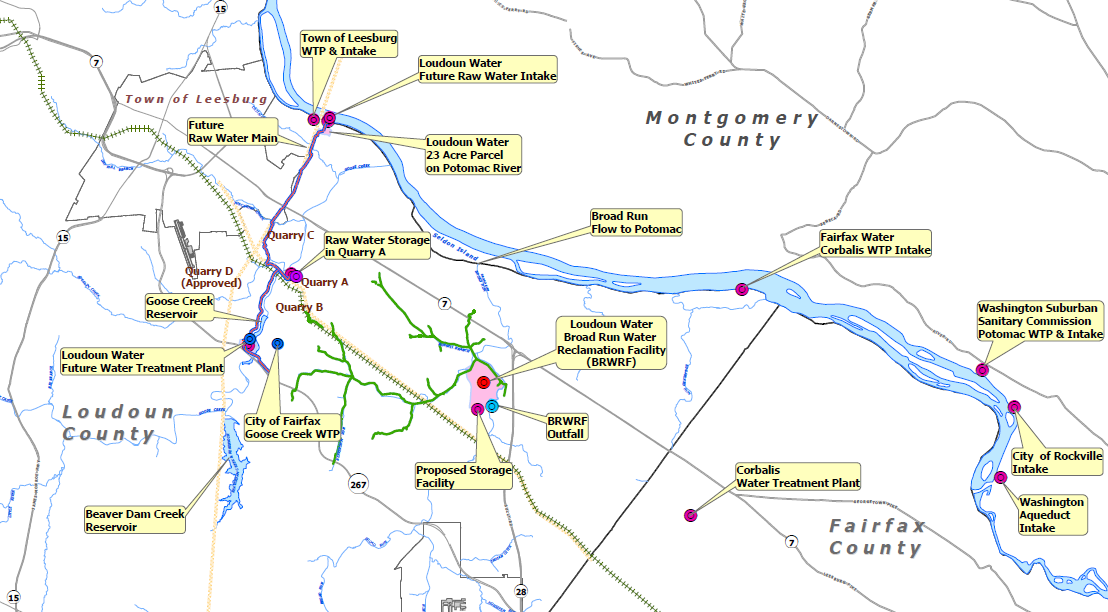
Loudoun's water banking solution was required in part because the City of Fairfax impounded Goose Creek
Source: Loudoun Water, Project Summary